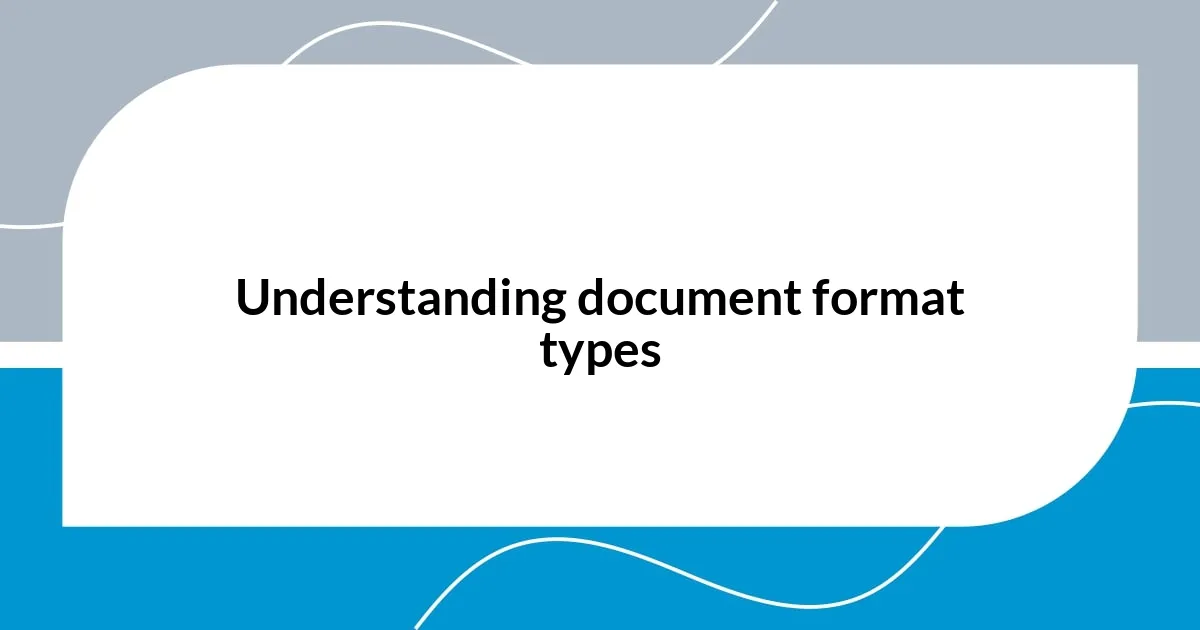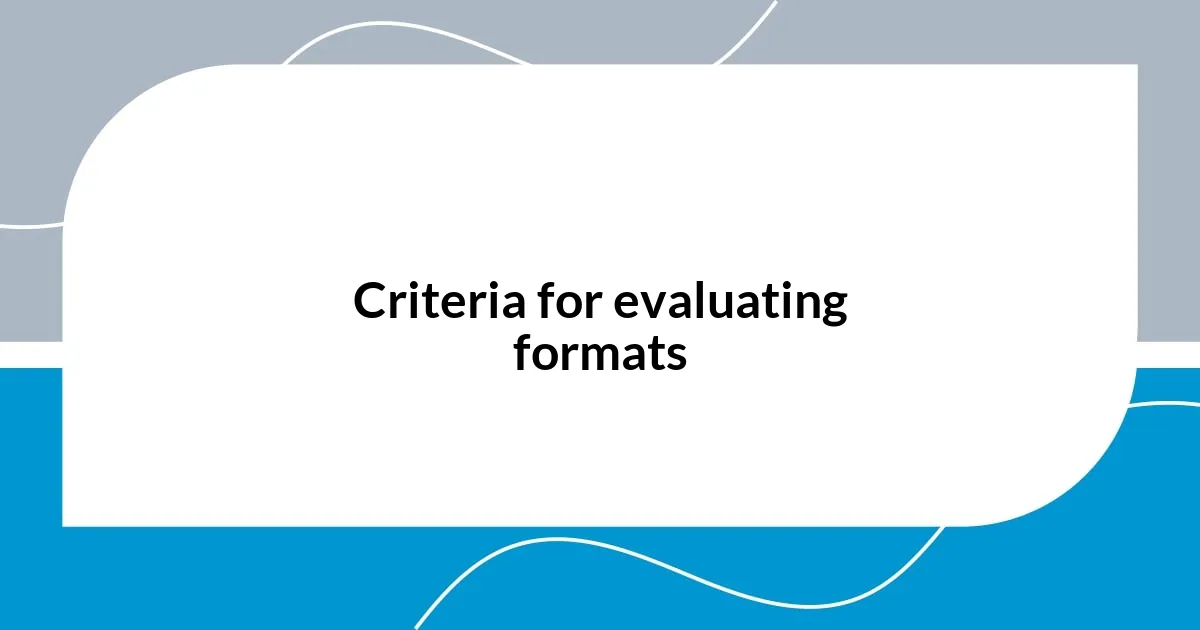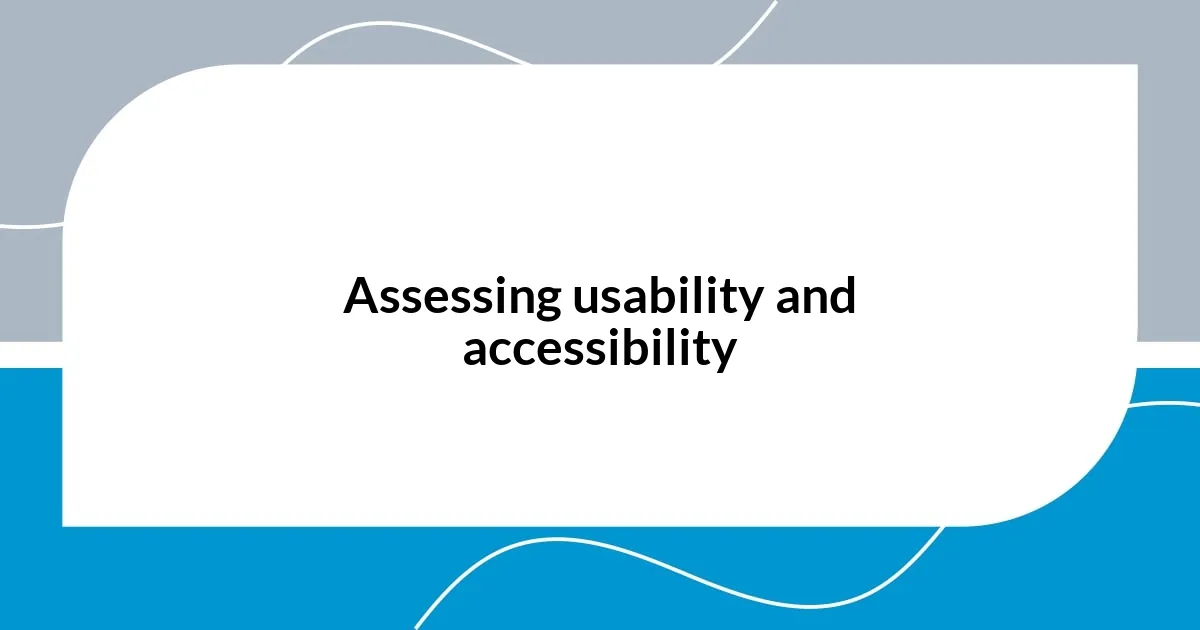Key takeaways:
- Document format choice significantly impacts how content is perceived and communicated, affecting professionalism and collaboration.
- Key criteria for evaluating formats include compatibility, editing flexibility, preservation of formatting, file size, and accessibility.
- Usability and accessibility are critical for effective communication; formats should support a diverse audience and intuitive navigation.
- Feedback and adaptability enhance document solutions, emphasizing the importance of collaboration in improving document effectiveness.

Understanding document format types
When I first began exploring document formats, I was overwhelmed by the sheer variety available—PDFs, DOCs, and even HTML files began to feel like a labyrinth. I remember my initial frustration in understanding why one format worked best for my resume, while another was ideal for my research papers. Isn’t it curious how a simple choice of format can affect how our documents are perceived?
Understanding the distinctions between these formats goes beyond technical specifications. For instance, using a PDF ensures that formatting remains intact, which I learned the hard way when a client opened my DOC file and found everything misaligned. Have you ever experienced a similar mishap? It really drives home the importance of selecting the right format to convey professionalism.
Then there’s the matter of accessibility. Some formats are inherently designed for collaboration, like Google Docs, allowing multiple users to edit simultaneously. I recall a project where this feature saved the day, enabling my team to share ideas in real-time, creating a dynamic and engaging environment. Isn’t it fascinating how the choice of a format can transform not just the document itself but the entire workflow?

Criteria for evaluating formats
When I evaluate document formats, I focus on a few key criteria. These elements not only determine how efficiently I can share information but also how the audience perceives the content. For example, I prefer formats that are universally compatible—like PDFs—as I’ve had my share of email back-and-forth when someone couldn’t open a DOC file. It’s amazing how something as simple as a file format can influence communication.
Here are some important criteria I consider:
- Compatibility: Ensure that the format can be easily opened across different devices and software.
- Editing Flexibility: Look for formats that allow for easy collaboration and edits, especially in team settings.
- Preservation of Formatting: Opt for formats that maintain the original layout to avoid misalignment issues.
- File Size: Consider the size of the file for easy sharing and storage.
- Accessibility: Choose formats that are accessible to everyone, including those with disabilities.
Every time I use a format that meets these criteria, I can’t help but feel relieved. It really enhances not just the deliverability of documents but also my confidence in how I present my work. Have you ever found yourself frustrated over a format that just didn’t cooperate? It’s a reminder of how crucial this seemingly mundane choice can be.

Commonly used document formats
Commonly used document formats each serve distinct purposes in communication. Among the most prevalent formats are PDF, DOCX, and TXT files. I distinctly remember the moment I sent a PDF to a potential employer; I was instantly relieved knowing that my carefully formatted document would appear just as I intended. Have you ever had that anxiety about how your work will look on someone else’s screen?
Another commonly used format is DOCX, which allows for easier editing and collaboration. I’ve found that working in this format is particularly useful during group projects, as it encourages dynamic input from team members. On the flip side, while DOCX files are great for editing, they can sometimes lose their formatting when converted or opened on different software. This was a lesson learned after a team member commented on how my document appeared “wonky” during our meeting!
Then there’s the TXT format, which is as simple as it gets. No frills, just plain text. I often use this format for jotting down quick notes or ideas when I need to focus solely on the content without distractions. It’s a no-nonsense approach, but it reminds me how sometimes, the simplest formats can be the most powerful in conveying raw thoughts and ideas.
| Format | Features |
|---|---|
| Preserves formatting, compatible on all devices, ideal for final versions | |
| DOCX | Editable, good for collaboration, can experience formatting issues |
| TXT | Basic text, no formatting, best for quick notes |

Assessing usability and accessibility
When assessing usability and accessibility, I take a close look at how easily different formats can be navigated by various users. For instance, I appreciate formats that support screen readers, such as tagged PDFs. I remember the first time I tested a document for accessibility; it felt rewarding to know that everyone, regardless of ability, could engage with the content. It raises an essential question: how can we ensure our choices empower all readers?
Another aspect I consider is the intuitive nature of the format. I’ve often found that overly complex layouts can deter users from engaging fully. One time, I shared a beautifully designed report that, despite its aesthetics, left some colleagues scratching their heads. They struggled to find the key information, which was a frustrating experience for all of us. This reminds me that usability must be a priority—can your chosen format easily guide users to their desired information without confusion?
In my experience, the interplay between usability and accessibility significantly impacts how effectively a message is communicated. I recall a project where we were tasked with creating materials for a diverse audience. Initially, we faced challenges with a complicated design that alienated some users. After simplifying the layout and adopting a more accessible format, feedback improved dramatically. It’s a clear illustration of how embracing usability and accessibility not only broadens reach but enhances engagement. How have you navigated similar challenges in your own work?

Analyzing compatibility with tools
When I assess document formats, compatibility with tools is a top priority. For instance, I’ve learned the hard way that a beautifully designed document in DOCX can create chaos when it’s opened in a basic text editor. Have you ever experienced that “Oh no!” moment when formatting goes awry? It’s a gut-wrenching feeling.
Equally important is the ability to convert files without losing integrity. I remember reaching for an editing tool that promised seamless PDF manipulation, only to face an unsightly layout on the other end. It made me realize how critical it is to ensure that whichever tools I choose to use, they maintain compatibility across various formats. What’s your experience with document conversion?
Lastly, I often evaluate how well the formats integrate with other tools I regularly use. For example, during a recent project, my team utilized a collaborative platform that worked seamlessly with Google Docs. It allowed real-time edits and feedback, making our workflow so much smoother. Isn’t it incredible how the right tools can enhance collaboration? It’s a constant reminder of the importance of choosing formats that can play well with others in our tech ecosystem.

Best practices for format assessment
When assessing document formats, I prioritize consistency in style and structure across different platforms. I once created a presentation that looked fantastic on my computer but completely fell apart when viewed on another device. Have you ever had to face the disappointment of your hard work not translating well? That experience taught me to always perform a thorough cross-platform check. It not only enhances reliability but also boosts my confidence that everyone sees the document as intended.
Another best practice I uphold is considering the intended audience and context for the document. For instance, while working on a report for a conference, I opted for a clean, straightforward layout over a more elaborate one. The feedback we received indicated that attendees appreciated the straightforward approach, which made the data easy to digest. This experience reinforced my belief that understanding your audience is critical. How often do we get too caught up in aesthetics and forget clarity and purpose?
Moreover, I find it invaluable to establish a clear criterion for assessing format suitability. In one of my projects, I created a checklist that included factors like readability, compatibility, and accessibility. This structured approach allowed my team to evaluate formats quickly and effectively. It was a game-changer, streamlining our decision-making process. Have you ever used a similar framework to guide your assessments? I believe that having a checklist not only saves time but also ensures that nothing important slips through the cracks.

Delivering effective document solutions
Delivering effective document solutions requires a keen understanding of user needs and the environment in which documents will be utilized. I recall a time when I was developing a user manual; the initial draft in a complex format looked stunning but was utterly impractical for my target audience, who primarily used mobile devices. Have you ever poured your heart into a design only to realize it doesn’t serve its purpose? This experience taught me that true effectiveness lies in prioritizing functionality over flair.
Another crucial aspect of effective document solutions is ensuring accessibility for all users. During a collaborative project, I opted for an interactive PDF, thinking it would be a breeze for everyone. But I wasn’t prepared for the feedback about the difficulties some had when using screen readers. It was a harsh but valuable lesson in the need for inclusivity in document formats. How often do we assume that our choices are suitable for everyone without confirming their accessibility?
Moving beyond just technical compatibility, I’ve found that embracing feedback can refine the effectiveness of my document solutions. After distributing a project update, I actively sought input from my colleagues about the format and layout. Their insights were eye-opening and reminded me that involving others in the assessment process not only improves the end product but also fosters teamwork. Don’t you think collaboration can unlock innovative ideas we might miss when working solo?